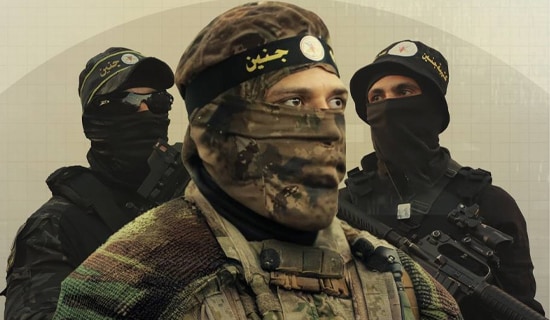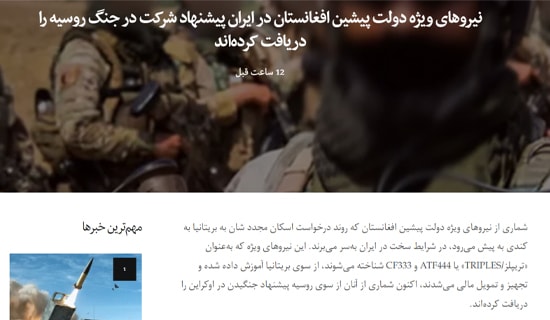
Screenshot of the U.N. Monitoring Team report
The Taliban's Commitments Vis-À-Vis The U.S.
On February 29, 2020, following long months of negotiations under the auspices of Qatar, the U.S. and the Islamic Emirate of Afghanistan (the Afghan Taliban) signed an agreement on the future of Afghanistan. In the agreement, the Taliban committed (Part Two, Article 3) to "prevent[ing] any group or individual in Afghanistan from threatening the security of the United States and its allies," adding that they would "prevent them from recruiting, training, and fundraising, and will not host them, in accordance with the commitments in this agreement."[1]
Left: U.S. Secretary of State Mike Pompeo shakes hands with Afghan Taliban leaders in Doha at the signing ceremony in Doha, February 29, 2020. Taliban deputy leader Mullah Baradar Akhund is in black turban in foreground (Source: Wall Street Journal) Right: Pompeo meets with Qatari Emir Sheikh Tamim bin Hamad Aal Thani on March 1, 2020. (Source: U.S. Embassy, Qatar)
A few days before the agreement was signed, U.S. Secretary of State Michael Pompeo paraphrased this clause, stating that "the Taliban must respect the agreement, specifically regarding their promises of severing ties with terrorists." He added: "We're not required to leave unless they can demonstrate they are fulfilling every element of their end of the bargain."[2]
Among these terrorists, the U.S.-Taliban Agreement specifically mentions Al-Qaeda, stating that the Taliban "will not allow any of its members, other individuals or groups, including Al-Qaeda, to use the soil of Afghanistan to threaten the security of the United States."[3]
On March 3, 2020, Pompeo further said that the Taliban "for the first time, have announced that they're prepared to break with their historic ally, Al-Qaeda, who they've worked with much [to] the detriment of the United States of America." He added that the Taliban "would work alongside of us to destroy, deny resources to and have al-Qaeda depart from that place [Afghanistan]."[4] However, a July 1, 2020 U.S. Department of Defense report noted that at the least, Al-Qaeda in the Indian Subcontinent (AQIS), an Al-Qaeda affiliate, continues to maintain "close ties" with the Afghan Taliban and is assisting "local Taliban leaders" in Afghanistan.[5] Moreover, a United Nations report published in June 2020 asserted that as of March 15 Al-Qaeda had strong, deep ties with the Taliban, thus raising doubts about the prospect of the Taliban's breaking with their ally.[6]
From The U.N. Report: The Taliban, While Discussing Peace With U.S. In Doha, Held Meetings With Al-Qaeda Leaders
Following are excerpts from the report by the United Nation's Analytical Support and Sanctions Monitoring Team, highlighting the deep ties between Al-Qaeda and the Islamic Emirate:[7]
1. "The Monitoring Team has frequently highlighted the link between Al-Qaeda and the Taliban in its reports, links that it assesses have remained strong since the removal of the Taliban regime 18 years ago" – i.e. since 9/11.
2. "Al-Qaeda and the Taliban held meetings over the course of 2019 and in early 2020 to discuss cooperation related to operational planning, training and the provision by the Taliban of safe havens for Al-Qaeda members inside Afghanistan."
3. "Al-Qaeda is covertly active in 12 Afghan provinces: Badakhshan, Ghazni, Helmand, Khost, Kunar, Kunduz, Logar, Nangarhar, Nimruz, Nuristan, Paktiya and Zabul."
4. "While it is difficult to be certain of the exact number of Al-Qaeda fighters in Afghanistan, the Monitoring Team's estimate is between 400 and 600 armed operatives."
5. "Al-Qaeda leadership detailed in meetings with the Taliban have included Ahmad Al-Qatari (not listed), Sheikh Abdul Rahman (not listed), Hassan Mesri (aka Abdul Rauf) (not listed) and Abu Osman (not listed), a Saudi Arabian member of Al-Qaeda."
6. "The Monitoring Team was informed of six reported meetings between Al-Qaeda and Taliban senior leadership held over the past 12 months. The most notable of these was a meeting in spring 2019 that took place in Sarwan Qal'ah District of Helmand Province, at which Sadr Ibrahim, Mullah Mohammadzai (not listed) and former adviser to Mullah Mohammad Omar, Gul Agha Ishakzai... reportedly met with Hamza Usama Muhammad bin Laden... to reassure him personally that the Islamic Emirate would not break its historical ties with Al-Qaeda for any price."
7. "[Al-Qaeda leader Ayman] Al-Zawahiri met with members of the [Taliban's] Haqqani Network in February 2020 [when the U.S. was about to sign the Doha agreement]. Hafiz Azizuddin Haqqani (not listed) and Yahya Haqqani... consulted al-Zawahiri over the agreement with the United States and the peace process. Yahya Haqqani has been the primary Haqqani Network focal point for liaison with Al-Qaeda since mid-2009."
From The U.N. Report: Al-Qaeda-Taliban Links Extend Also To ISIS In Afghanistan, Pakistani Jihadi Organizations
8. "The presence in Afghanistan of Al-Qaeda, particularly in the form of Al-Qaeda in the Indian Subcontinent, was demonstrated most clearly on 22 September [2019] when a joint United States-Afghan operation targeted a suspected Taliban and Al-Qaeda gathering in the Shabaroz area of Musa Qal'ah District, Helmand Province."
9. "Additional information suggested that discussions were held among senior Haqqani Network figures to form a new joint unit of 2,000 armed fighters in cooperation with and funded by Al-Qaeda. The newly established unit would be split into two operational zones with Hafiz Azizuddin Haqqani in overall command and leading forces in the Loya Paktiya area (Khost, Logar, Paktika and Paktiya), while the remaining force would be deployed to Kunar and Nuristan under Shir Khan Manga, the head of intelligence for the Haqqani Network."
10. "The Taliban appear to have strengthened their relationship with Al-Qaeda rather than the opposite. One [U.N.] Member State reported that the regularity of meetings between Al-Qaeda seniors and the Taliban 'made any notion of a break between the two a mere fiction.' The link was described not in simple terms of group-to-group, but rather as one of deep personal ties (including through marriage) and long-term sense of brotherhood."
11. "Member States observed that while Al-Qaeda has a presence beyond Afghanistan, the historical connection between the terrorist group and the country is not lost on a plethora of Al-Qaeda-aligned militant groups who have celebrated the [U.S.–Taliban] agreement as a victory for the Taliban cause, and consequently for the larger global militant cause."
12. "Estimates by Member States and others of overall Taliban annual combined revenues range from $300 million to upwards of $1.5 billion per annum. While officials noted lower figures for 2019, they were careful to note that the Taliban used resources effectively and efficiently and were not experiencing a cash crisis."
13. "Attacks claimed by ISIL-K [ISIS in Afghanistan] demonstrated some degree of 'involvement, facilitation, or the provision of technical assistance' by the Haqqani Network"; "[ISIL-K takes] responsibility for [terror] operations that had, in all likelihood, been carried out by the Haqqani Network"; "operations resulting in civilian casualties allow Taliban deniability whereas ISIL-K is willing to claim responsibility to demonstrate capability and relevance."
14. "Among those [foreign] groups posing a security threat, Afghan officials highlighted Tehrik-e-Taliban Pakistan..., Jaish-i-Mohammed... and Lashkare-Tayyiba... [aka Lashkar-e-Taiba]"; "The presence of these groups is centred in the eastern provinces of Kunar, Nangarhar and Nuristan, where they operate under the umbrella of the Afghan Taliban"; "the total number of Pakistani nationals fighting with terrorist groups in Afghanistan may be as high as 6,000 to 6,500."
Implications For The Future Of The U.S.–Taliban Agreement
The U.S.-Taliban Agreement, signed in Doha on February 2020, was preceded by 18 months of talks between the U.S. and the Islamic Emirate. During this period, while the Taliban were making promises to the U.S., they were also actively engaging with Al-Qaeda and had maintained some links with ISIS in Afghanistan, as the U.N. report shows.
However, the most relevant assertion in the U.N. Report concerns the intricate ties between the Taliban and Al-Qaeda: "The Taliban appear to have strengthened their relationship with Al-Qaeda rather than the opposite. One [U.N.] Member State reported that the regularity of meetings between Al-Qaeda seniors and the Taliban 'made any notion of a break between the two a mere fiction.' The link was described... as 'one of deep personal ties (including through marriage) and long-term sense of brotherhood... Al-Qaeda capitalizes on this through its network of mentors and advisers who are embedded with the Taliban, providing advice, guidance and financial support. The Taliban offensive against Ghazni City in August 2018 was a prime example of the effective deployment of Al-Qaeda support."
In view of these observations, the U.S.'s expectation that the Taliban will sever their ties with Al-Qaeda and expel them from Afghanistan is hardly realistic. Therefore, Secretary Pompeo's implied conditioning of continued U.S. withdrawal of its forces from Afghanistan on the Taliban's fulfilment of their commitments ("We’re not required to leave unless they can demonstrate they are fulfilling every element of their end of the bargain") becomes a catch-22: The U.S. will either need very convincing arguments to withdraw its forces from Afghanistan while Al-Qaeda still thrives there, or remain there for many more years.
How did the U.S. administration get into such a situation? This is puzzling when we recall that Qatar, that actually sponsored the Taliban-U.S. agreement and supported the Taliban throughout the negotiations, is known not only for its long-time ties with Al-Qaeda terrorist activity, but also for providing safe haven, according to Richard A. Clarke, National Coordinator for Security and Counter-terrorism in the Clinton and Bush administrations, to 9/11 mastermind Khalid Sheikh Muhammad (KSM). Qatar spirited KSM away hours after a U.S. law enforcement officials asked Qatar's emir, in 1996, to hand him over. As Clarke explained, "within hours of the U.S. ambassador's meeting with the Emir [Sheikh Hamad bin Khalifa Aal Thani], Sheikh Muhammad had gone to ground. In tiny Doha, no one was able to find him." He concluded: "Had the Qataris handed him over to us as requested in 1996, the world might have been a very different place"[8] – that is, 9/11 would never have happened. The role of the Qatari royal family in KSM's disappearance was underlined in the 9/11 Commission Report as well.[9]
The 9/11 Commission Report described Khalid Sheikh Muhammad as "the principal architect of the 9/11 attacks" who held his job at the Qatari Ministry of Electricity and Water but was allowed by the Qatari royal family to escape when the U.S. tried to arrest him.
Thus, given what is well known and documented about Qatar's relationship with Al-Qaeda's leaders and operatives, why would the U.S leadership trust Qatar during its negotiations with the Taliban? Furthermore, why would the U.S. seriously believe that the trio of Qatar-Taliban-Al-Qaeda was willing to produce a credible agreement, that would enable the American forces to withdraw from Afghanistan stating "Mission Accomplished"? It seems that the answers to these questions can be found only within the U.S. government.
* Yigal Carmon is President and Founder of MEMRI; Tufail Ahmad is Senior Fellow for the MEMRI Islamism and Counter-Radicalization Initiative.
[1] State.gov (U.S.), February 29, 2020.
[2] U.S. Department of State, Remarks to the Press, Washington D.C., February 25, 2020.
[3] State.Gov (U.S.), February 29, 2020.
[4] Michael Pompeo, Face The Nation, CBS News, March 1, 2020.
[5] ToloNews.com (Afghanistan), July 2, 2020.
[6] Undocs.org/S/2020/415, accessed June 11, 2020. The U.N. report is titled "Eleventh report of the Analytical Support and Sanctions Monitoring Team submitted pursuant to resolution 2501 (2019) concerning the Taliban and other associated individuals and entities constituting a threat to the peace, stability and security of Afghanistan."
[7] More highlights from the U.N. report on further links between the Afghan Taliban and Al-Qaeda:
i) "It was… confirmed that the leader of Al-Qaida in the Indian Subcontinent, Asim Umar, had been killed in the attack, along with several foreign nationals, including the group's deputy, its 'courier' to al-Zawahiri and several foreign female members. Umar and his followers were being sheltered by local Taliban forces, some of whom had also been killed in the raid."
ii) "In October 2019, 11 Taliban were released from Bagram Airfield detention facility in exchange for three Indian engineers who had been kidnapped in Afghanistan. Those Taliban included former shadow governors Sheikh Abdul Rahim (not listed) and Mawlawi Rashid Baluch (not listed). Rahim is thought to be an appointment of the Haqqani Network, while Baluch was previously listed by the United States Department of the Treasury, which emphasized his role in 'the Taliban and Al-Qaida nexus.'"
iii) "Estimates by Member States of the number of Taliban fighters range from 55,000 to 85,000. As previously reported by the Monitoring Team..., Taliban facilitators and non-combatants could bring the total figure to 100,000."
iv) "Sources had indicated in 2019 that two former Taliban commanders of ethnic Tajik and Uzbek origin from Kunduz Province, Mawlawi Satar (from Imam Sahib District) (not listed) and Mawlawi Abdullah Majid (from Khanabad District) (not listed) had gone to fight for ISIL-K [the ISIS branch for Afghanistan] in Achin District of Nangarhar."
v) "While Member State estimates of ISIL-K strength in Afghanistan continue to vary, the Monitoring Team assesses their strength at approximately 2,200 armed fighters, most of them in Kunar Province."
vi) "Lashkar-e-Tayyiba and Jaish-i-Mohammed were stated to have approximately 800 and 200 armed fighters, respectively, co-located with Taliban forces in Mohmand Darah, Dur Baba and Sherzad Districts of Nangarhar Province. Tehrik-e-Taliban Pakistan also maintains a presence in Lal Pura District, near the border area of Mohmand Darah, Pakistan. In Kunar Province, Lashkar-e-Tayyiba retains a further 220 fighters and Jaish-i-Mohammed has a further 30, all of whom are dispersed within Taliban forces."
[8] Nydailynews.com/opinion/knew-qatar-trouble-article-1.3306729, July 6, 2017.
[9] MEMRI Inquiry & Analysis No. 1485, Qatar's Role In 9/11 And Hosting Jihadi Commanders; Afghan Taliban's Hideouts Move To Safe Haven Of Doha, November 19, 2019.





